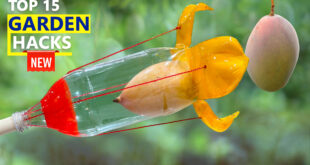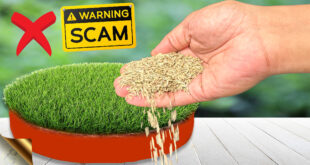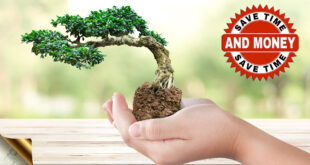Whether you’ve been a gardener for few days or many years, mistakes in the garden are sometimes inevitable, and it’s a big part of the learning process. Let’s discuss some of the common mistakes we commit and find solutions to them one by one.
- Placing or Planting Identical Plants together or in a row: This may sound weird but it’s true. Though it may look nice with a tidy row of similar trees in your garden or even if it’s container gardening, you tend to place one type of similar plants together. This is a bad idea because If pests or disease strikes, you’ll lose the whole row.
- Transplanting a Seedling: Many gardeners tend to hold the little ones with their tender stems. This is wrong, because stems are tender and this can damage the water and food conducting tubes – that’s xylem and phloem passing through the stem. Always lift the seedlings by their leaves and use a fork or a spoon to dig through the roots.
- Immediately Repotting a Newly Purchased Plant from a Nursery: If your plant just came home from a local garden centre or nursery, let it adjust to its new environment for atleast a week before repotting it. This is because the Plants are already in shock in their new place and they need to adapt to new factors like light, temperature, and humidity conditions. On the contrary, if your purchased a plant online, you have to repot it immediately for reasons, quite obvious.
- Over Confidence: One of the biggest mistakes sometimes experienced gardeners make is over-reliance on their own experience and knowledge. You are never perfect and the most successful gardeners are usually those who are willing to continue learning and growing in their knowledge.
- Removing the Root Ball while repotting: Never pull out the plant by its stem to remove the root ball. Just tap the container on a hard surface gently, it will easily come out. If it resists, run a knife around the container to loosen the root ball.
- Using Contaminated or Dirty Tools: We’ve all been guilty of this one time or another. Digging in different pots of soil with the same tool can transfer pathogens from an afflicted plant to a healthy one. Investing in multiple sets of trowels or spades may not seem to be practical. What you can do is disinfect or clean the tool after use or just wash it with water. You can use household baking soda or even vinegar for cleaning your tools.
- Placing a Repotted plant in Direct Sunlight: This is another common mistake most of us commit. The plant is already in transplant shock after repotting. Always keep the plant in indirect light or shade for at least a week before you shift to full sunlight.
- Planting Too Close Together: That’s Spacing: Whether its planting seeds or saplings, planting too close to each other is not useful and will lead to stunted growth of plants due to competition for nutrients in the soil.
- Sowing Too Deeply: This is a common mistake most neophytes commit. If you sow too deep, the seed may not germinate. The general rule of thumb is, the seeds should be sown twice or max thrice as deep as they are thick. For example, if the seeds are 5mm thick, sow them 10mm deep. If the seeds are too tiny like less than 1 mm, simply sprinkle them on the top of soil.
- Removing the Mother Soil during repotting: You should never remove the entire mother soil in which the plant came with during purchase, unless the soil is too clayey or if its afflicted with disease like fungus gnats or stuff like that. Just tease the roots and place the root ball into the new container while repotting.
- Killing Beneficial Insects and Pollinators like honey bees and butterflies. And also the pest eating insects like ladybugs, beetles and many more.
- Over Watering: This is the most common mistake and the biggest plant killer. Over watering or water suffocating the roots can lead to root rot and death of the plant. The best practice is to dip your finger to about an inch into the soil to check for moisture before watering.
- Over Fertilizing: Over feeding the plant with fertilizers especially the chemical fertilizers in an attempt to make them grow faster can literally kill your plant. The best fix to this problem is to use organic fertilizers like vermicompost, decomposed cowdung and stuff like that and stay away from chemical fertilizers.
- Not Following Hardening-Off Process: Hardening Off means you gradually expose your seedlings to the outside world mainly the sunlight and get them acclimatized. Once you get your first leaves on your seedlings, you introduce them to sunlight in an incremental or step by step exposure like for example,1 hour for the first day, 2 hours for the next 2 days and so on.
- Not Closely Inspecting Pest Attacks: Pests need to be identified and eliminated carefully. Failure to control the pests like aphids, whiteflies, mealy bugs and others can cause heavy damage to your plants.
- Hesitating to Prune or Trim Your Plants: Pruning or trimming is very much beneficial to the plant and promotes more branching and hence increases the yield. You can watch a detailed video on when and how to prune from a link in description below.
- Allowing Weeds to grow: This is an act of laziness rather than mistake. Unwanted plants or weeds will suck out the nutrients from the soil and cause deficiency issues in your main plant.
- Not knowing the Importance of Sunlight: Without Sunlight, Plants cannot prepare their food and survive. However the light requirement for every plant is different. But expecting to grow vegetables and fruits without full sunlight exposure is a mistake. As a general rule for most flowering and fruiting plants at least six to eight hours a day of direct sunlight is indispensable.
- Planting invasive plants close to other plants. This can cause deficiencies in the weaker plants closer to the stronger invasive ones. As You all know – SURVIVAL OF THE FITTEST!
- Relying on Unscientific Information in Gardening: This is the most dangerous mistake. Newbie gardeners tend to watch so many crappy non-scientific gardening information and advices on the internet and damage their plants. Little bit of common sense and applying some basic science is all that’s necessary for successful gardening.
Happy Gardening!
 GKVKs – Gardening Tips and Store Gardening Tips and Store
GKVKs – Gardening Tips and Store Gardening Tips and Store



